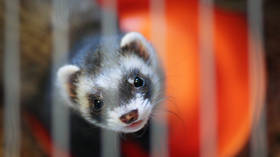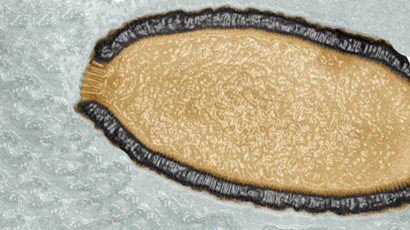700-yo virus from ancient caribou poop revived, infects living plant

Scientists have successfully revived a 700-year-old virus that was frozen within ancient caribou feces, using it to infect a modern-day plant. The development raises the possibility that global warming could resurrect other infectious viruses.
READ MORE: Rare footage captures Ebola discovery in 1976 (VIDEO)
Scientific knowledge of ancient viruses is limited due to poor
preservation and low concentrations, but genetic engineering is
helping scientists replicate ancient viruses, and study how they
interact with contemporary plants.
By replicating an age-old virus from ancient Canadian caribou
feces (aCFV), researchers with the Blood Systems Research
Institute in San Francisco say they have learned that viruses can
remain infectious for centuries, motherboard.com reported.
“We demonstrate that genetic material from ancient viruses
associated with caribou fecal matter was cryogenically preserved
for at least seven centuries, and that the cloned DNA genome of
one of these viruses replicated and spread systematically in an
extant plant,” Eric Delwart wrote in a study published in
Proceedings of the National Academy of Sciences.
What could possibly go wrong? http://t.co/cSCqoOWQ21
— Dolph Pun (@DolphPun) October 29, 2014
READ MORE: Tuberculosis epidemic much worse than people think – WHO
However, the infection didn’t show up as an outward symptom of
the disease, and to prove the plant was infected Delwart
sequenced the genomes of newly-grown leaves on the plant. He was
able to detect and isolate the viral DNA which had replicated
inside the plant. There were no outward symptoms on the plant
because tobacco wasn’t the virus’ original host. Whatever plant
was the host, though, remains ancient history.
The virus was discovered in a Canadian ice patch, and because it
had remained frozen for so long, the virus’ DNA was still in good
shape and easy to separate as distinct from caribou DNA.
700-Year-Old Viruses Found —in Frozen Caribou Poop http://t.co/TG7D2Qyxckpic.twitter.com/xwOxx8juQW
— Scott Brooks (@Scotty_Brooks) October 29, 2014
In another instance earlier this year, a French research couple found a 30,000-year-old virus frozen in the Siberian tundra. Scientists knew the virus’ host was an amoeba and tried seeing if the ancient virus could prove infectious. What they discovered when they tested their hypotheses was the amoebae were dying off, and the viruses were multiplying inside.
READ MORE: Scientists revive giant virus from 30,000-year-old Siberian permafrost
"Sixty percent of its gene content doesn't resemble anything
on Earth," Chantal Abergel at Aix-Marseille University told
Nature about the virus.
Scientists have long known that viruses can survive for hundreds
or thousands of years – after all, latent smallpox virus genes
were discovered in 400-year-old mummies back in 1990. Still, an
alarm is starting to sound about what happens when the Earth’s
ice melts and the viruses preserved in ice start to revive. Will
they prove harmful to human or animals?
“There will be people where there were no people before, and
those people are going to manipulate and disturb those [soil]
layers that have not been disturbed for a million years,”
said Claverie.
Delwart says studying the origins of certain viruses is good
preparation to respond to ancient viruses if they do happen to
become unfrozen and infectious.
"As climate change accelerates the melting of arctic ice, it
is possible that ancient viral particles and the associated
nucleic acids could be released into the environment," he
wrote. "If such virions are infectious, their release could
contribute to the diversity of circulating viruses."
"Ancient virus resurrected. http://t.co/Xccc3cSviu" Just another day at the office here
— Simon Araque (@JohnShortcut) October 29, 2014














